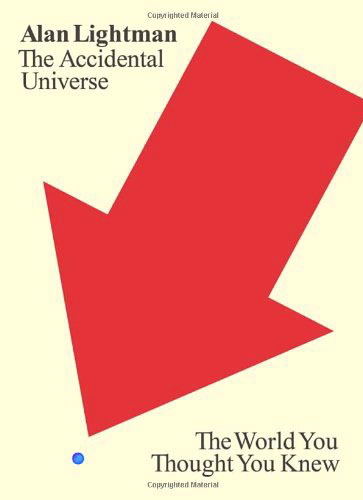Philosophy and science are typically the stuff of textbooks, not page-turners. But Alan Lightman’s engaging new book of essays proves to be the exception. Indeed this MIT physicist-turned-bestselling author is one of the nation’s top science writers, exploring the intersection of science and culture. That he used to teach physics in the morning, and creative writing in the afternoon is all the recommendation you need.
His new book, “The Accidental Universe: The World You Thought You Knew” shows Lightman to be an able and charming tour guide. These seven essays are more like Sunday strolls than lectures, more leisurely than pedantic. When Lightman delivers a dose of theory or abstraction, it’s animated by real life, often his own. So, for instance, while expounding on the second law of thermodynamics, he’s also describing the demise of his beloved wingtips; our attachment to old photographs; and the allure, for some, of tummy tucks and toupees. Through these varied examples, he makes a point about our longing for permanence and immortality in a constantly changing world. As a result, a bedrock law of physics takes on a decidedly human cast.
Throughout the book, Lightman juxtaposes scientific principles alongside their real world counterparts. In his essay, “The Symmetrical Universe,” Lightman recalls his first viewing of Saturn through a telescope, its concentric rings astonishing. He moves on to more earthbound examples – snowflakes and starfish, the yellow iris, the wings of a butterfly. To the human eye, symmetry may represent order and beauty; but it’s also nature’s form of efficiency. The so-called energy principle has been guiding nature along this path for eons.
“Nature evolves to minimize energy,” Lightman says. “Symmetry leads to economy, and nature, like human beings, seems to prefer economy.”
Chapter by chapter, Lightman deconstructs some of the key concepts in modern science – String Theory, the Standard Model of Physics, Wave-Particle Duality – and he introduces some of the scientists behind them. Turns out that their rules and theories – there’s actually a concept known as the Theory of Everything – are essentially efforts to explain the universe, to seek order in a disorderly world. One comes to realize that faith and science may be at odds, but that science is its own form of religion.
Dualities of this sort form the backbone of Lightman’s essays, where seeming opposites manage to co-exist. Lightman explores disparities between the spiritual and scientific worlds, wherein one requires proof, and the other is beyond rational analysis. Both forces were at work near the author’s summer home in Maine, where a family of ospreys had taken up residence. From one year to the next, Lightman and his wife recorded their habits, their comings and goings. Then one summer afternoon, two baby ospreys left the nest, making eye contact with the author, if only briefly. It was a transcendent moment for which he has no explanation, that left him shaking and in tears.
As the osprey story suggests, “The Accidental Universe” portrays a physicist who not only observes his environment, but interacts with it, as well. While this lively, lyrical book examines some of the major scientific thinking of our time, it also celebrates the human drive to make sense of it all.
Joan Silverman writes op-eds, essays, and book reviews. Her work has appeared in The Christian Science Monitor, Chicago Tribune and Dallas Morning News.
Send questions/comments to the editors.



Success. Please wait for the page to reload. If the page does not reload within 5 seconds, please refresh the page.
Enter your email and password to access comments.
Hi, to comment on stories you must . This profile is in addition to your subscription and website login.
Already have a commenting profile? .
Invalid username/password.
Please check your email to confirm and complete your registration.
Only subscribers are eligible to post comments. Please subscribe or login first for digital access. Here’s why.
Use the form below to reset your password. When you've submitted your account email, we will send an email with a reset code.